Release 0 minimal infrastructure
Minimal Infrastructure
The minimal infrastructure requirements for installing and running OSM Release 0 are 2 servers and 1 switch:
- The first server will run 5 VMs:
- RO (OpenMANO)
- NSO (Riftware)
- CM (Juju Server)
- An additional virtual machine (AVM) for operation support (containing an openmano CLI client and a Juju CLI client)
- A Virtualized Infrastructure Manager (VIM)
- The second server will act as a compute node controlled from the VIM.
- The switch is intended to handle simultaneously different networks:
- Datacenter infrastructure network (used by the VIM to talk to the compute nodes)
- Datacenter telco/VNF management network (equivalent to a traditional telco management network, used by the CM to configure the VNFs)
- Data plane networks (networks between VMs that use interfaces based on SR-IOV or Physical Port pass-through)
- Other virtual networks (networks between VMs that use Linux bridges, virtual switches like OVS, etc. when the VMs are located in different compute nodes)
Next figure shows the minimal infrastructure setup. The type and number of interfaces are only an example.
A zoom on the servers show how the OSM components interact each other, with the infrastructure (compute nodes and switches) and with the VNFs:
Multi-datacenter infrastructure
The previous section showed the infrastructure and logical networks for a reduced setup for testing purposes. For an appropriate setup involving several datacenters, a different infrastructure is required. The main difference resides on the infrastructure for each datacenter. In the figure below, 2 datacenters are shown (based on OpenVIM and OpenStack respectively), and both are controlled from the OSM server. Both datacenters require connectivity to the OSM components


